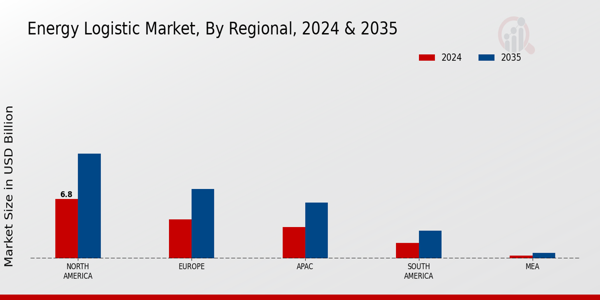Rising Demand for Renewable Energy
The increasing The Energy Logistic Industry. As countries strive to meet their carbon reduction targets, the demand for logistics services that support renewable energy projects, such as wind and solar farms, is surging. In 2025, investments in renewable energy logistics are projected to reach approximately 300 billion dollars, reflecting a robust growth trajectory. This shift necessitates specialized logistics solutions to transport equipment and materials efficiently, thereby enhancing the operational capabilities of the Energy Logistic Market. Furthermore, the integration of renewable energy into existing grids requires sophisticated logistics planning to ensure timely delivery and installation, which further propels the market forward.
Regulatory Support for Clean Energy
Government regulations and policies aimed at promoting clean energy are significantly influencing the Energy Logistic Market. Many countries are implementing incentives and subsidies for renewable energy projects, which in turn increases the demand for logistics services that support these initiatives. For example, tax credits for solar and wind energy projects have led to a surge in logistics requirements for transporting materials and equipment. In 2025, it is anticipated that regulatory frameworks will continue to evolve, further encouraging investments in clean energy logistics. This supportive environment not only fosters growth in the Energy Logistic Market but also encourages companies to adopt more sustainable practices, thereby enhancing their competitive edge.
Increasing Global Energy Consumption
The rising The Energy Logistic Industry. As populations grow and economies develop, the demand for energy continues to escalate. In 2025, global energy consumption is projected to increase by approximately 25%, necessitating enhanced logistics capabilities to manage the distribution of various energy sources. This surge in demand requires efficient transportation and storage solutions, particularly for fossil fuels and renewable energy products. Consequently, logistics providers are compelled to innovate and expand their services to meet these growing needs. The Energy Logistic Market must adapt to this dynamic landscape, ensuring that it can effectively support the increasing energy demands of diverse markets.
Technological Innovations in Logistics
Technological advancements are reshaping the Energy Logistic Market, introducing new efficiencies and capabilities. Innovations such as automation, artificial intelligence, and blockchain technology are streamlining logistics operations, reducing costs, and improving transparency. For instance, the implementation of AI-driven analytics can optimize route planning and inventory management, which is crucial for energy logistics. In 2025, it is estimated that logistics companies investing in these technologies could see a 20% reduction in operational costs. Moreover, the adoption of blockchain can enhance traceability in the supply chain, ensuring that energy products are sourced and delivered sustainably. This technological evolution not only boosts the efficiency of logistics operations but also aligns with the growing demand for sustainable practices in the Energy Logistic Market.
Shift Towards Decentralized Energy Systems
The transition towards decentralized energy systems is reshaping the Energy Logistic Market. As more consumers and businesses adopt distributed energy resources, such as rooftop solar panels and battery storage, the logistics of energy distribution become increasingly complex. This shift necessitates a reevaluation of traditional logistics models, as energy must be delivered more flexibly and responsively. In 2025, it is expected that decentralized energy systems will account for a significant portion of energy generation, prompting logistics companies to develop tailored solutions for local energy distribution. This evolution not only enhances the resilience of energy supply chains but also presents new opportunities for innovation within the Energy Logistic Market.



















Leave a Comment